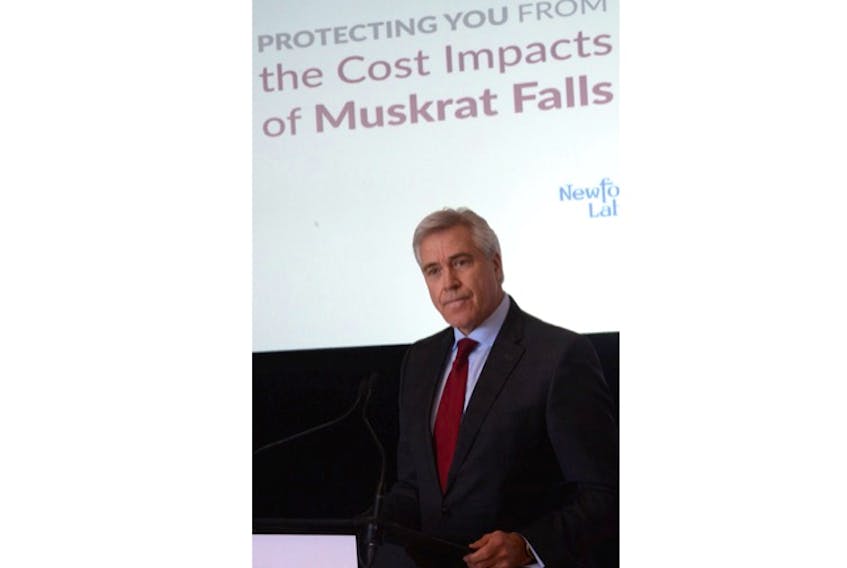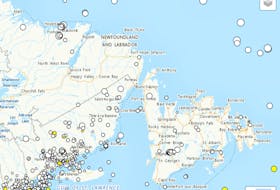ST. JOHN'S, N.L. — There are many actions required to avoid a sharp jump in power rates in Newfoundland and Labrador as a result of the wildly over budget Muskrat Falls hydroelectric project, and the Liberal government on Monday laid out its plans.
The target is to keep the average, island, residential rate at 13.5 cents per kilowatt hour in 2021. The current rate is 12.3 cents. Without any response, rates were forecast to leap to 22.9 cents.
Politically and practically, it was always expected something would be done. The question was exactly what, and how effective those efforts might be.
All in all, the Liberals’ plan will require $725.9 million total in new revenue and annual savings in power production, all to be applied to keep rates down.
It will require use of Nalcor Energy revenues that otherwise might have gone to the government for public services; unspecified cuts at Nalcor Energy; auctioning of an unspecified amount of firm power; leveraging federal funding programs targeting greenhouse gas reductions and — perhaps most significantly — settling an arrangement with the federal government to reduce the yearly costs to the province for the Muskrat Falls project.
At the Confederation Building in St. John’s, MP Seamus O’Regan said the federal government is ready to “get under the hood” of the province’s power rate problem, highlighting a visit by federal Finance Minister Bill Morneau on April 5 for closed-door discussions.
“That’s much more than, I think, a political commitment. I think rate mitigation, frankly, is a moral commitment,” O’Regan told reporters when asked about federal help with rate mitigation.
Premier Dwight Ball has said little about what that might involve.
“This is not about exchanging a cheque,” he said Monday. “This is about restructuring a financing model that’s already in place.”
“This is not about exchanging a cheque. This is about restructuring a financing model that’s already in place.” — Dwight Ball
The New Democrats criticized the Liberals’ rate mitigation plan — including a federal-provincial arrangement — as a “grab bag of ideas” and a last-minute attempt to buy votes.
The Progressive Conservatives accused the Liberals of several shortcomings, but focused on the $200-million annual savings the Liberals expect to achieve through a deal with Ottawa, referring to it as nothing but a commitment of “tricky Liberals.”
The PCs had been calling for the Liberals to present a power plan, even issuing their own rate mitigation plan — the Crosbie Hydro Energy Action Plan (CHEAP) — in March.
Regardless of the letterhead, the plans face many variables and no guarantees when it comes to keeping rates to a manageable level.
“Our plan will help ensure stable and predictable electricity rates for consumers across the province. This includes businesses and large industrial customers,” Ball declared at the grand unveiling in the lobby of Confederation Building.
But the plan also, for example, requires the retirement of the main plant at the Holyrood Thermal Generating Station as a power producer. That transition has been questioned as of late, in timing and approach, based on reliability concerns. Not having the same transition would alter expected savings on diesel fuel and forecasted revenue from sale of carbon credits.
Reliability is an issue the Public Utilities Board (PUB) is examining.
At Nalcor Energy
The new rate mitigation plan does incorporate cuts to Nalcor Energy, targeting $20 million in annual savings.

There has been no detail on what might be involved in the cuts as the current government envisions. It also remains unclear to what degree the government would need to or be willing to step in to the work of the Nalcor Energy board, to assure cost savings are achieved.
Nalcor Energy was not represented at the unveiling of the new rate mitigation plan.
Natural Resources Minister Siobhan Coady has spoken previously about joint efforts towards rate mitigation and said the corporation is fully apprised.
“Nalcor has been working with government and its rate mitigation committee over the past few years to offer information and data regarding options to mitigate rates,” read a statement from the corporation supplied to The Telegram, attributed to president and CEO Stan Marshall.
“As well, Nalcor is fully engaged in the PUB's review of options to mitigate rates. We are aware of the options available and will continue to support the efforts to manage electricity rates in the best interest of customers.”
The PUB and oversight
Ball said at one point the Public Utilities Board has been brought in to provide “oversight” of the Muskrat Falls project by the Liberal government. But the board has no oversight role on the project’s construction cost or financing.
The PUB is, however, working through its own review of all options available for rate mitigation. Public comments are being welcomed, with public hearing dates expected this fall. A final report is due to the government by Jan. 31, 2020.
The PUB’s work has included an interim report, released in February, informing the current rate mitigation plans.
As for timing, the Liberals suggest there are measures that could be introduced beyond 2021, as Muskrat Falls costs hit, to further help ratepayers. That includes new energy conservation measures, exploration of additional ways to reduce peak power demand (like time of day pricing), promotion of increased use of electric vehicles and possible new power planning with the other Atlantic provinces.
Liberal Muskrat Falls mitigation plan
The Government of Newfoundland and Labrador’s plan for dealing with the dire projections for power rates as of 2021 requires both finding savings within the system and new revenues.
A total of $725.9 million annually is expected to be needed to stabilize power rates at about 13.5 cents per kilowatt hour — the Liberals’ target.
The suggestion is the $725.9 million could be found as follows:
- Collaborate with Government of Canada (undefined means of savings) — $200 million
- Nalcor dividend (Nalcor was previously ordered to identify money for rates from export sales and oil and gas revenue) — $200 million
- Newfoundland and Labrador Hydro operational savings (including savings after a transition of the Holyrood power plant) — $178.2 million
- N.L. Hydro surplus energy (sales including recapture power from Churchill Falls and Schedule 2 excess power from Muskrat Falls) — $49.1 million
- Organizational changes (savings from restructuring and cuts)— $20 million
- Muskrat Falls operations and maintenance (reducing expected annual cost) — $12 million
- Isolated diesel systems (adding renewables to reduce costly diesel use) — $7.4 million
- Fuel switching/electrification (targeting government buildings to start with) — $15 million
- Add value to energy surplus (adding data centres; auctioning a portion of surplus energy to new user) — $35.5 million
- Holyrood performance credits (sale of carbon credits) — $8.7 million
RELATED









